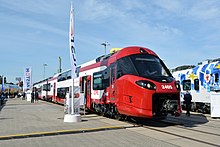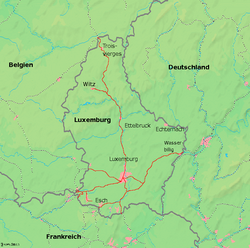The Société Nationale des Chemins de Fer Luxembourgeois (French pronunciation: [sɔsjete nɑsjɔnal de ʃ(ə)mɛ̃ də fɛʁ lyksɑ̃buʁʒwa]; Luxembourg National Railway Company; abbr. CFL [seɛfɛl]) is the national railway company of Luxembourg. In 2023, it carried approximately 28.7 million passengers. As of 2023, the company employs around 5,000 people, making CFL the country's largest corporate employer.[3]
 | |
| Company type | Government-owned corporation |
|---|---|
| Industry | Rail transport |
| Founded | 14 May 1946 |
| Headquarters | Luxembourg City, Luxembourg |
Area served | Luxembourg, parts of Belgium, France, Germany |
Key people | Jeannot Waringo, President Marc Wengler, Director-General |
| Products | Rail transport, Cargo transport |
| Revenue | €1.073 billion (2022)[1] |
| €4.4 million (2013) | |
| €13 million (2022) | |
| Owner | 94% Luxembourgish state, 4% Belgian state, 2% French state |
Number of employees | 5,000 (2023)[2] |
| Website | www |
| Chemins de Fer Luxembourgeois | |||||
|---|---|---|---|---|---|
 CFL Class 2400 train in Luxembourg. | |||||
| Operation | |||||
| National railway | Chemins de Fer Luxembourgeois | ||||
| Statistics | |||||
| Ridership | 28.7 million (2023)[2] | ||||
| Passenger km | 388.8 million (2022)[1] | ||||
| Freight | 2,438 million tonnes kilometres (2022)[1] | ||||
| System length | |||||
| Total | 630 km (391 mi) | ||||
| Double track | 140 km (87 mi) | ||||
| Electrified | 574 km (357 mi) | ||||
| Track gauge | |||||
| Main | 1,435 mm (4 ft 8+1⁄2 in) | ||||
| High-speed | 1,435 mm (4 ft 8+1⁄2 in) | ||||
| Electrification | |||||
| 25 kV 50 Hz AC | 576 km (358 mi) | ||||
| |||||
The Luxembourg rail system comprises 275 route-kilometres (170 miles), of which 140 kilometres (87 mi) is double track and 135 kilometres (84 mi) single track. Of the total track length of 617 kilometres (383 mi), 576 kilometres (358 mi) are electrified at 25 kV, 50 Hz.[4]
Luxembourg borders Belgium, France and Germany. Correspondingly, there are cross-border services into these countries. Some are wholly run by CFL, whereas others are run by SNCF, NMBS/SNCB and DB. CFL passenger trains cover most of the network.
CFL operates most of its passenger trains using EMUs and electric locomotives with push-pull stock. The company also has a fleet of diesel locomotives for hauling freight trains and for general shunting purposes.
Luxembourg is a member of the International Union of Railways (UIC). The UIC Country Code for Luxembourg is 82.
History
CFL is the result of a nationalisation of private railway companies in 1946.
CFL operations and services
Passenger train routes
CFL advertises its passenger network as made up of seven lines:[5]
- Line 10 Luxembourg – Troisvierges-Frontière – Liège (Belgium), Kautenbach – Wiltz and Ettelbrück – Diekirch
- Line 30 Luxembourg – Wasserbillig-Frontière – Trier (Germany)
- Line 50 Luxembourg – Kleinbettingen-Frontière – Brussels (Belgium)
- Line 60 Luxembourg – Esch-sur-Alzette – Rodange, Bettembourg – Volmerange-les-Mines (France), Noetzange – Rumelange and Esch-sur-Alzette – Audun-le-Tiche (France)
- Line 70 Luxembourg – Rodange – Athus (Belgium), Rodange – Longwy (France)
- Line 90 Luxembourg – Thionville (France) – Metz (France) – Nancy (France)
Internally it uses a different system with more sub divisions:[6]
- Ligne 1 Luxembourg – Troisvierges-Frontière, 1a Ettelbruck – Diekirch, 1b Kautenbach – Wiltz
- Ligne 2a Kleinbettingen – Steinfort, 2b Ettelbruck – Bissen
- Ligne 3 Luxembourg – Wasserbillig-Frontière via Sandweiler-Contern
- Ligne 4 Luxembourg – Berchem – Oetrange, 4a Luxembourg - Alzingen
- Ligne 5 Luxembourg – Kleinbettingen-Frontière
- Ligne 6 Luxembourg – Bettembourg-Frontière, 6a Bettembourg – Esch/Alzette, 6b Bettembourg – Dudelange-Usines (Volmerange), 6c Noertzange – Rumelange, 6d Tétange – Langengrund, 6e Esch-sur-Alzette – Audun-le-Tiche, 6f Esch-sur-Alzette – Pétange, 6g Pétange – Rodange-Frontière (Aubange), 6h Pétange – Rodange-Frontière (Mont St. Martin), 6j Pétange – Rodange-Frontière (Athus), 6k Brucherberg – Scheuerbusch
- Ligne 7 Luxembourg – Pétange
Rail links to adjacent countries
All neighbouring countries have 1,435 mm (4 ft 8+1⁄2 in) standard gauge railways, but only France uses the same electrification of 25 kV AC:
Ridership
Passenger ridership carried on CFL-trains for each fiscal year (x 1000).[7][1]
- 1938: 9,505
- 1950: 10,607
- 1960: 10,643
- 1970: 12,531
- 1980: 14,053
- 1990: 12,692
- 2000: 12,985
- 2006: 14,793
- 2007: 16,442
- 2008: 17,676
- 2009: 17,039
- 2010: 17,996
- 2011: 18,200
- 2012: 19,834
- 2013: 20,714
- 2014: 21,503
- 2015: 22,496
- 2016: 22,459
- 2017: 22,930
- 2018: 23,331
- 2019: 25,016
- 2020: 14,500
- 2021: 16,600
- 2022: 22,000
- 2023: 28,700
Passenger kilometers on CFL-trains for each fiscal year (x 1,000,000).[7][1]
- 1938: 215
- 1950: 227
- 1960: 230
- 1970: 256
- 1980: 302
- 1990: 261
- 2000: 332
- 2006: 298
- 2007: 233
- 2008: 345
- 2009: 333
- 2010: 347
- 2011: 349
- 2012: 373
- 2013: 385
- 2014: 409
- 2015: 418
- 2016: 417
- 2017: 438
- 2018: 443
- 2019: 463
- 2020: 269
- 2021: 304
- 2022: 389
Rolling stock

CFL owns a relatively modern fleet of passenger trains, with a majority of double-decker trains. Nearly all routes are operated with electric trains.
Projects
In 2019, doubling of track between Luxembourg railway station and Sandweiler-Contern at a cost of €462 million was completed, following an original planned 2013 opening.[8] A new, more direct, line between Luxembourg and Bettembourg is due to open in 2027.[9]
See also
References
Further reading
External links
Wikiwand - on
Seamless Wikipedia browsing. On steroids.

